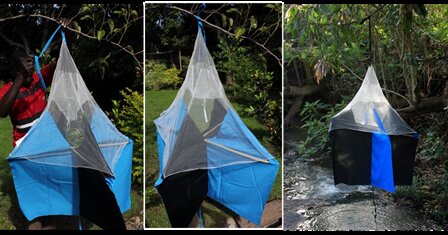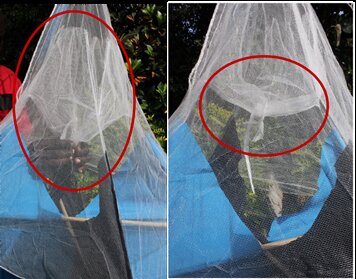How to assemble and use a Pyramidal trap for capturing tsetse.
Traps should be placed in good tsetse habitat close to water and visited regularly (every 24 to 48 hours) to collect and remove flies. Each trap samples an area of about 50m radius, so traps can be placed 100m apart. Remember, these traps are not treated with insecticide and only captures flies for monitoring purposes.
Step 1

Each trap requires to wooden sticks. Cut two sticks which are long enough to reach across the width of the trap.
Step 2

Place the first stick through the open part in the centre of the trap, and insert the point into the corner pocket.
Step 3

Place the other end of the stick into the opposite corner pocket so that the trap is stretched out.
Step 4

Insert the 2nd stick into the other two corner pockets, so that the trap is stretched open by the crossing sticks.
Step 5

Tie the trap to a branch or stick in good tsetse habitat with the bottom of the trap about 30cm above the ground or water surface.
Step 6

Close the collection cage inside the white netting with a small knot. This is where flies will be collected.
Step 7

Do regular monitoring of the trap and record the position (GPS), date and number of flies caught. To remove the flies, place the trap flat on the ground and open the collection cage. Flies will die due to exposure to the sun and dehydration. If there are still live flies in the cage, gently squeeze the flies’ thorax (chest) between thumb and index finger, which will crush the flight muscles so that the fly can be handled easily. Record the data and replace the trap.
Sometimes ants may climb into the trap collection cage and remove flies. To avoid this, place grease or Vaseline around the branch on which the trap is tied.